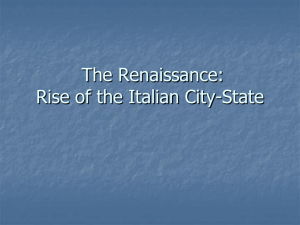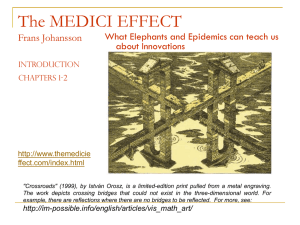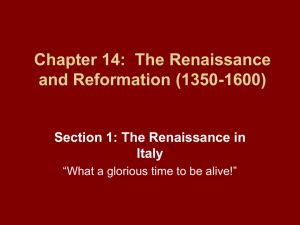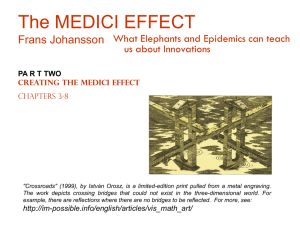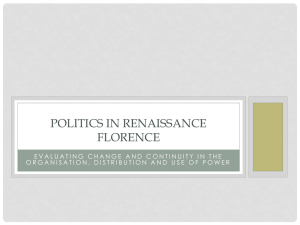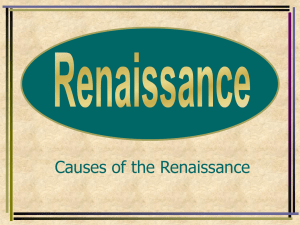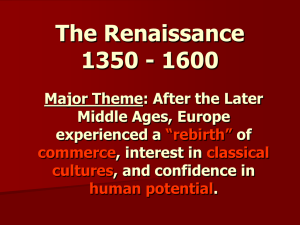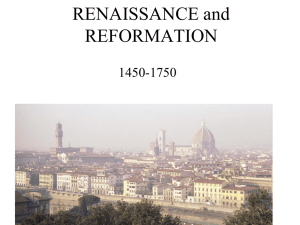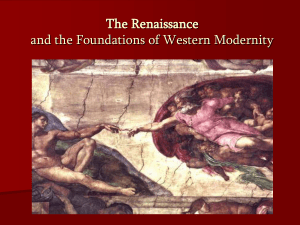leonardo intricate
advertisement
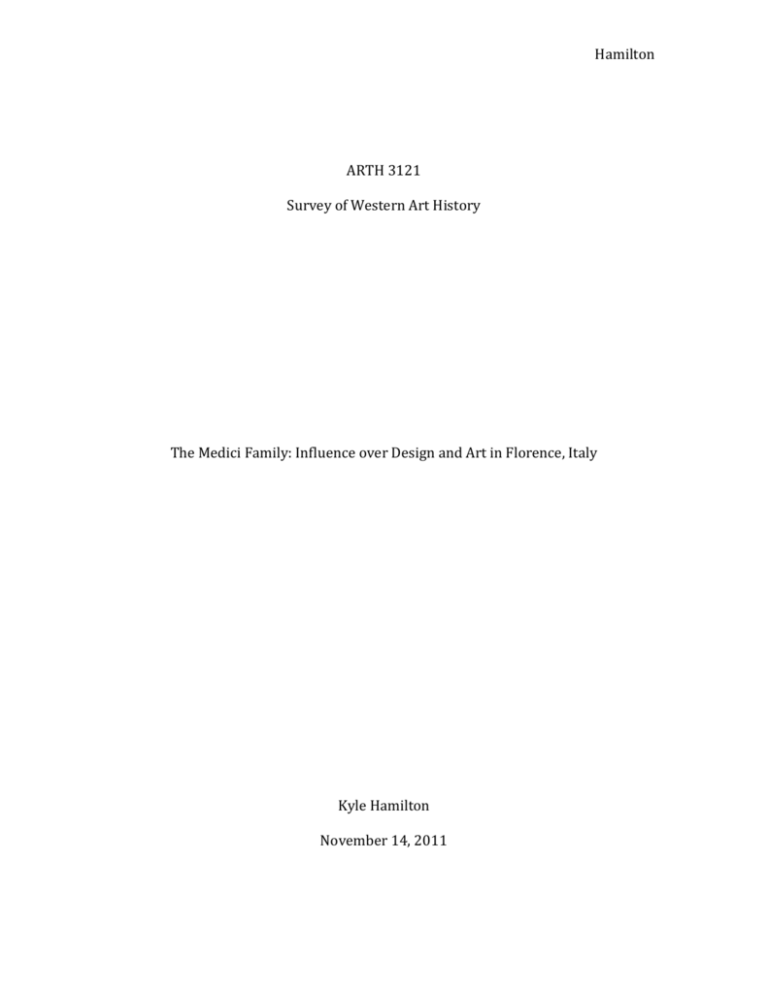
Hamilton ARTH 3121 Survey of Western Art History The Medici Family: Influence over Design and Art in Florence, Italy Kyle Hamilton November 14, 2011 Hamilton The Italian Renaissance began the opening phase of the Renaissance. The Renaissance was a period of great cultural change and achievement in Europe that spanned from the end of the 13th century to the1600s. It was a time of rebirth for art, design, music, and culture in Italy. It was marking the transition between Medieval and Early Modern Europe. This was a time where the wealthy had great influence over the changes occurring in the Renaissance. One prominent family of this time was the Medici Family. Florence was the main city where their influence was greatly seen. The Medici had an influential lifestyle that greatly affected the styles of art and design through the Renaissance period in Florence. Florence was a city that was reborn during the Italian Renaissance. The Medici Family were not the average royal family, but earned their wealth through commerce, trade, and banking. Their wealth was amassed even more by, “bankrolling popes and kings. Through their wealth and their political abilities, they went from being one of many patrician clans in Florence to the city’s hereditary rulers.”1 The Medici were lovers of art and scholars. Leonardo, Raphael, Botticelli, Galileo, Michelangelo, and Cellini were just a few of the many artists and scholars they invested their interest and funds. This caused Florence to become a prime city of art and culture during the Renaissance. Giovanni Medici started the success of the line of their influence in Florence. He used banking to make Florence the city to be for what was the latest in art, design, and culture. This created connections between lands far and near, this also brought the newest philosophies, writings, art, and design to Florence. It allowed Bob Brier. Antonio Fornaciari. Gino Fornaciari. “Secrets of the Medici.” Archaeology, Volume 58, Issue 4. Pgs. 36-41. 1 Hamilton Florence to be the hot spot of Europe. This caused some tension between Rome and Florence, but it ended up having the two cities feed off each other. The investments of the Medici Family’s money set up their way to take over the political scene of Florence. Giovanni’s son, Cosimo, followed in his footsteps to become a powerhouse controller over Florence, Italy without even having an official office or position. Not only were the Medici controllers of the government, but also the church system. The Medici Family, were not just attendants of the Basilica di San Lorenzo, but also took pride in embellishing and reconstructing their church. Michelangelo was a favorite artist of the Medici Family. The family took him in when he was thirteen years old. He was discovered for his artistic talents and the Medici raised him amongst future royals, allowing to nurture his artistic ways. This was a direct link to the fact that the Medici Family were a big influence on Michelangelo and his style of art and design. Michelangelo always pushed the limits of the possible by embracing his own self-creativity and ideas.2 One of his greatest and most influential projects in Florence is the burial chapel in the Medici church of San Lorenzo. The chapel includes a number of largerthan-life-sized marble statues, among them the famous portrayal of the four times of day personified: Day, Night, Dawn, and Dusk. During the 1520s and 1530s, Michelangelo carved most of the New Sacristy sculptures as well as the sculpture known to be seen as Apollo but also David. Many are unsure whether Michelangelo originally intended to represent the biblical hero, David, which was a symbol of the 2 Acidini Luchinat, Cristina, Palazzo Strozzi. The Medici, Michelangelo, & the Art of Late Renaissance Florence. Art Institute of Chicago, and Detroit Institute of Arts. New Haven. June 2002. Pgs. 6-30. Hamilton Florentine republic, or if the artist planned to finish the marble as Apollo, the sun god; who would later become the emblem of the Florentine art academy and its patron, Cosimo.3 Michelangelo was the original designer of the Basilica, but the marble façade was never completed. The interiors in the Renaissance period were very elegant with white walls and gray column arcades. Inside are two bronze pulpits designed and created by Donatello. Cosimo the Elder, the first Medici ruler, is buried under a marble inlay design in front of the alter. Manetti built the cloister in 1462. It has a beautiful garden with a formal layout of hedges and pomegranate trees. After walking through the cloister it leads to the library. Michelangelo was commissioned by Giulio di Giuliano de’ Medici to create the design of the library. He started the construction in 1525, but left in 1534 so other architects had to finish his work. This design was one of a kind and to this day still very original in its layout. When entering the lobby there is a grand staircase, designed by Ammannati in 1559. There is a reading room that has bench seating. The Medici Family acquired a massive collection of historic manuscripts and books. They are valuable and prized collection housed in the library. There is also the Medici chapel where the majority of the family are entombed. This building has an entrance from the Piazza Madonna degli Aldobrandini. From the first floor, one takes the stairs up to the Cappella dei Principi. The Chapel of princes has six dukes entombed there under a large dome that was constructed by Buontalenti. It reflects the design of the dome on the Florence Cathedral. The Giancarlo Fiorenza. “The Medici, Michelangelo, and the Art of Late Renaissance Florence.” CAA Reviews. 2. 3 Hamilton décor on the inside took centuries to perfect. It has elaborate marble finishes that were finally completed in 1962. The walls have the sixteen coats of arms hung to represent all the large cities in Tuscany. There are also two sculptures of the grand dukes, Cosimo II and Ferdinando I. They never completed the sculptures for the four remaining dukes. This chapel is now attached to the sacristy, which was designed by Michelangelo. The sacristy houses many of the church furnishings along with statues and other décor.4 Cosimo inherited his family's interest in art patronage for the glorification of the dynasty, and he significantly improved the Medici collections. His acquisitions reveal a wide-ranging interest in contemporary painting from Florence, and an ongoing commitment to the Medici workshops. These establishments continued to produce luxurious objects, with a gradual shift from the complex and intricate Mannerist designs of the Florentine court artists to the bold, dramatic language of the Baroque. Cosimo encouraged his court painters and the new artists’ of the Florentine art academy, in the development of a repertory of images that communicated Medici power and rule over Florence. The painters Pontormo and Agnolo Bronzino created a court portrait style for the Medici family. It was characterized by courtly grace and opulence relating to power and military might. Bronzino and his workshop produced a plethora of portraits of Cosimo, his family, the grand duke’s ancestors, Giancarlo Fiorenza. “The Medici, Michelangelo, and the Art of Late Renaissance Florence.” CAA Reviews. 3. 4 Hamilton and other of members of the court.5 Bronzino was commissioned by a member of the elite Medici circle to create a religious work, Holy Family with Saint John the Baptist, it is one of the painter’s most well-known works. Its references to specific examples of ancient Greek and Roman sculpture which was recognizable and appreciated by the learned patron along with his colleagues. Pontormo, who was better known for his paintings of religious subjects, was awarded numerous and very important commissions by Cosimo, including the decoration of the choir of the Medici church of San Lorenzo. These frescoes are now gone, but have remnants within the church that give an idea of what the works style were like.6 The Medici also had a luxurious style of design and art when it came to their own residences. Cosimo de’ Medici hired Michelozzo Bartolomeo to design the Palazzo Medici Riccardi. It is in the heart of Florence. When looking at the building, as the floors go up, the stories of each floor decrease. The stone masonry is a noticeable and successful design aspect. As the stories go up, the stonework goes from a rougher, rustic look to a smooth finished stone. The first floor of the building is where the help and animals were kept. The top floor was one of the main living areas in the house. This was a creative way to distinguish the floors yet do it in a playful way to create a unique design. The interior of the Palazzo reveals an inner courtyard. There are large columns with high archways in between each column. The walls have a classic style Gary Ianziti. “Leonardo Bruni, the Medici, and the Florentine Histories.” Journal of the History of Ideas 6, No. 1. Pgs. 3-5. 6 Robert W. Gaston. “Pontormo, Bronzion, Allori: A Genealogy of Florentine Art.” CAA Reviews. 1-3. 5 Hamilton with carved details above the arches. Under the covered areas the doorways and niches have intricate carvings above. The immense detail just alone in the courtyard reveals a lavish lifestyle. 3 The interior rooms have a baroque style to the details of the rooms. The Galleria in the Palazzo is grand in style and has a beautiful mural on the ceiling. The walls have immense detailing and are covered with gold. The Medici Family had exquisite taste in design and proudly flashed it through the overall design of their Palazzo.7 The Medici Family later gained the property of the Villa Medici. It was located on Pincio Hill. The family took control over this property in 1576. On the outside of this property are ornate décor of reliefs. There are many statues held in niches around the Villa. The loggia holds two lion statues and adjacent to them is the fountain that showcases the sculpture of Mercury. It sits between a simplistic and clean lined walkway of hedges and a few tall trees. The Villa offers a very decorative yet sensitive approach to design on the outside and in the garden. 4 It was one of the more elaborate Villas at that time.8 Piero di Medici was a strong influence on the design aspects in the San Miniato al Monte during 1448. He created the falcon impresa, which was first used for the Tabernacle of the Crucifix. When looking at the façade of San Miniato al Monte, one will notice the arcading decorating the exterior walls with the mosaic of Christ above the arcading. The complex is made up of the Bishop’s Palace, the cemetery, the Basilica, and the fortification; it looks over the city of Florence. Maureen C. Miller. “The Medici Renovation of the Florence Arcivescovado.” Tatti Studies. Pgs. 94-114. 8 Clara Bargellini. Pierre da a Ruffiniere du Prey. “Sources for a reconstruction of the Villa Medici, Fiesole.” Burlington Magazine 111, No. 799. Pgs. 597-605. 7 Hamilton On the inside of the Basilica are marble intarsias depicting the zodiac symbols. The walls were covered with frescoes dating back to the 13th century. There is also a mosaic of the Blessing Christ flanked by Madonna and Saints, which is in the apse of the church. Spinello Aretino was hired to tell a story through frescoes of the sixteen stories of the legend of St. Benedict. At the center of the church is the Chapel of the Crucifix designed by Michelozzo.9 Lorenzo de’ Medici was also a lover of architecture and design. He helped find the artist to do the façade on the Cathedral of Santa Maria del Fiore. He hosted a competition to decide on the artist to do the façade. Originally it was only half completed and the city decided to redo the façade in its entirety. The project wasn’t started until the 19th century due to a scandal during the competition. Emilio de Fabris was ultimately chosen to do the façade on the Florence Cathedral. It was finally completed in 1887. The design is in white, green, and red marbles. It is a simplistic color scheme but provides great contrast and depth to the façade. It is a beautiful and intricate design that represents the cultural inspirations that were going on in Florence at that time.10 The structure of this church took even longer than the façade to complete. The dome was the crowning element to the cathedral. The addition of this wasn’t started until after over 100 years of work. Arnolfo di Cambio was the original visionary of this cathedral and it’s dome. By Florence sponsoring this design for Linda A. Koch. “Power, Prophecy, and Dynastic Succession in Early Medici Florence: The Falcon Impresa of Piero di Cosimo de’ Medici.” Zeitschrift Fur Kunstgeschichte, no. 4. Pgs. 507-538. 10 Philip Foster. “Lorenzo de’ Medici and the Florence Cathedral Façade.” Art Bullentin 63, No. 3. 495. 9 Hamilton their new cathedral, they were breaking away from the highly gothic style churches and heading into a new way of design for their church. This cathedral is a statement piece in Florence and in the heart of the city.11 There were issues during the construction of the dome because the Florentines were the first to try to dome a dome with such great height. The structure seemed unstable and Brunellechi was brought in to take on this project. With a lot of ideas, he brought the vision to life with the help of chains, rails, and cross ties. His design for this construction was advanced for their times and considered many engineering skills. Between the brick layout to the imaginary circle supports throughout the dome, it became a success. It is amazing to think that this design was done based off a small-scale model and instincts from a confident architect.12 Florence is a city that is ever changing with times. The Renaissance put it on the map for the city to be in, at that time. The Medici Family had their hands in every aspect of the running of this city. Whether it was politics, the church, artwork, or design, the Medici Family was on top of it. The wealthy only became more powerful at this time. Life was happy and the rebirth of all the aspects on a day to day basis, brought light to the darker gothic once known. From having Michelangelo create one of a kind sculptures and designs to hosting competitions that would make a statement that Florence was going against the classically known cathedral designs, Amy R. Bloch. “Santa Maria del Fiore: The Cathedral and Its Sculpture.” CAA Reviews. 1-3. 12 Marvin Trachtenberg. “Brunelleschi, Ghiberti, and “L’occhio” minore of Florence Chathedral.” Journal of the Society of Architectural Historians 42, No. 3. 249-257. 11 Hamilton the Medici brought insight to it all. It is seemed to believe that without the Medici Family’s influence during the Renaissance in Florence, it would have never reached the level of sophistication and originality achieved. Hamilton Annotated Bibliography Brier, Bob. Fornaciari, Antonio. Fornaciari, Gino. “Secrets of the Medici.” Archaeology, Volume 58, Issue 4. July/August 2005. Pgs. 36-41. This piece focuses on the excavation of the Medici Family in Florence, Italy. This will give direct insight to the lifestyle of the Family and their very elaborate and wealthy life. Secrets that were once kept under wraps are now revealed. Miller, Maureen C. “The Medici Renovation of the Florence Arcivescovado.” Tatti Studies. Pgs. 89-116 This article provides information on how the Medici Family started their gain in power and the palaces they lived in throughout their days of reign over Florence. Cohen, Edie. “Fit for a Medici.” Interior Design, Volume 77, Issue 6. May 2006. Pgs. 272-279. This article discusses the Medici’s art collection in great detail and the lengths they went through to preserve it and allow it to grow. Acidini Luchinat, Cristina, Palazzo Strozzi. The Medici, Michelangelo, & the Art of Late Renaissance Florence. Art Institute of Chicago, and Detroit Institute of Arts. New Haven. June 2002. Pgs. 6-30. In this book it discusses the Medici Family and the influence they have over Michelangelo’s art in Florence during the Renaissance. Hamilton Gascoigne, Bamber. “History of the Medici.” HistoryWorld. From 2001, ongoing. http://www.historyworld.net/wrldhis/PlainTextHistories.asp?historyid=aa2 4. This website gives a summary of the Medici Family and what occurred in Florence during the Renaissance It also discusses the ending of the Renaissance period. Bargellini, Clara, and Pierre de la Ruffiniére du Prey. "Sources for a reconstruction of the Villa Medici, Fiesole." Burlington Magazine 111, No. 799. October 1969. Pgs. 597-605. This magazine offers information on the décor and reconstruction of the Villa Medici. Koch, Linda A. "Power, Prophecy, and Dynastic Succession in Early Medici Florence: The Falcon Impresa of Piero di Cosimo de' Medici." Zeitschrift Für Kunstgeschichte, No. 4. October 2010. Pgs. 507-538. This piece informs the reader of the design aspects in the San Miniato al Monte during 1448. Foster, Philip. "Lorenzo de' Medici and the Florence Cathedral Facade." Art Bulletin 63, No. 3. September 1981. Pgs. 495. This bulletin offers information about the process of Medici finding the designer for the façade of the cathedral. Fiorenza, Giancarlo. "The Medici, Michelangelo, and the Art of Late Renaissance Florence." CAA Reviews. March 15, 2004. 1-3. Hamilton This piece discusses the Medici Family, Michelangelo and the art created during the Ranaissance. It brings up the more famous works and designs of Michelangelo. Ianziti, Gary. "Leonardo Bruni, the Medici, and the Florentine Histories." Journal Of The History Of Ideas 69, no. 1. January 2008. Pgs. 1-22. It discusses Cosimo and his influence over the art community through many different things. It explains how he controlled and delegated the designing of many things at this time. Gaston, Robert W. "Pontormo, Bronzino, Allori: A Genealogy of Florentine Art." CAA Reviews. November 24, 2003. 1-3. This discusses the works that Pontormo and Bronzino were hired to do during the Renaissance and what they were well known for in the Renaissance. Trachtenberg, Marvin. "Brunelleschi, Ghiberti, and "L'occhio" minore of Florence Cathedral." Journal Of The Society Of Architectural Historians 42, no. 3. October 1983. Pgs. 249-257. This Journal will help explain the process Brunelleschi went through while working the Santa Maria del Fiore’s dome. Bloch, Amy R. "Santa Maria del Fiore: The Cathedral and Its Sculpture." CAA Reviews. August 12, 2002. 1-3. This gives an overview of the whole design and building process of the Santa Maria del Fiore.
